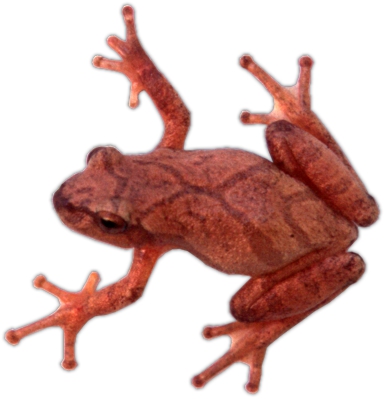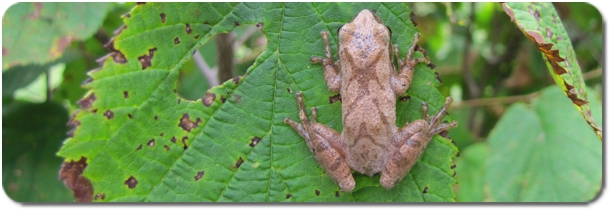Spring Peeper

What it looks like
The Spring Peeper is a small treefrog. An adult is only about 2.5 cm long. They are usually light brown in colour with some dark bands or stripes. Spring Peepers always have an "X" shaped mark on their backs.
Look-alikes
Spring Peepers are about the same size and colour as Boreal Chorus Frogs. But peepers always have an "X" mark on their back. Boreal Chorus Frogs don't have this mark.
Name
This frog gets its name because the males make a loud "peep" when they are calling for mates in the spring.
Scientific Name
The Spring Peeper's scientific name is Pseudacris crucifer. Learn what that means on this page: Scientific Names.
Where it lives
Spring Peepers live in forests and are usually found near ponds or other wetlands. They are found in eastern North America. In Manitoba they are found in the southeast, mainly east of Lake Winnipeg.
Where Spring Peepers live in North America.
Habits
Spring Peepers hunt for food mostly at night and hide in the daytime. They are a kind of treefrog, but they don't climb high from the ground. They stay in low bushes or thick grass. They spend winter under the leaves on the forest floor. They are one of the four kinds of amphibians in Manitoba that can freeze solid and live.

A Spring Peeper hanging on a leaf.
Food Web
Spring Peepers eat small insects, like mosquitoes and flies, and other tiny invertebrates like spiders or small worms.
Spring Peepers are so small that most large animals won't bother to eat them. Their main enemies are small snakes such as young garter snakes. Their tadpoles are eaten by small snakes and large water insects.
Life Cycle
Spring Peepers mate and lay eggs in late April or early May. They breed in ponds that fill from melting snow or in small year-round ponds.
| Hear the Spring Peeper mating call: |
Females lay their eggs one at a time on the bottom of ponds. The eggs hatch in 3 to 5 days. The tadpoles change to treefroglets after about 40 days, in early July. The new treefroglets are tiny, about 1 cm long.
Numbers
Spring Peepers are very common in southeastern Manitoba, but they are so small and hard to find that no one knows how many might live in one hectare.
Special Things
Spring Peepers are another kind of amphibian that spends winter above ground and can freeze solid and survive.
The call that the males make is very loud for such a tiny animal. When lots of Spring Peepers are peeping at once it is very hard to locate one individual. This makes it hard for predators to find them.
How to Find Spring Peepers
Listen for males calling from May to early June. Evening is the best time to hear them. Spring Peepers are tiny and stay hidden during the day, so it is rare to see one. But keep your eyes peeled on low shrubs while walking along trails in forested areas.
Use by People
Most people have never seen a Spring Peeper, but anyone who lives in southeastern Manitoba would know the sound these frogs make. Some people record the sounds of Spring Peepers and other animals and sell recordings of the sounds.
| Next treefrog: Boreal Chorus Frog | Back to: Amphibians and Reptiles Front Page |
